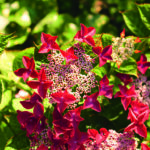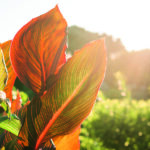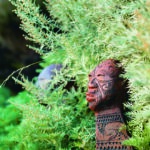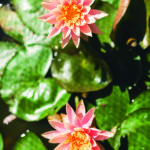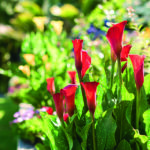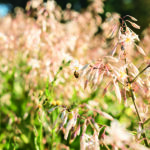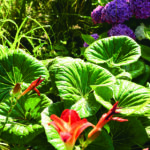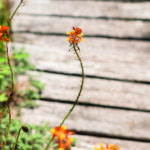Jack and Gill went up the Okitu Beach hill to create a flourishing garden spectacle
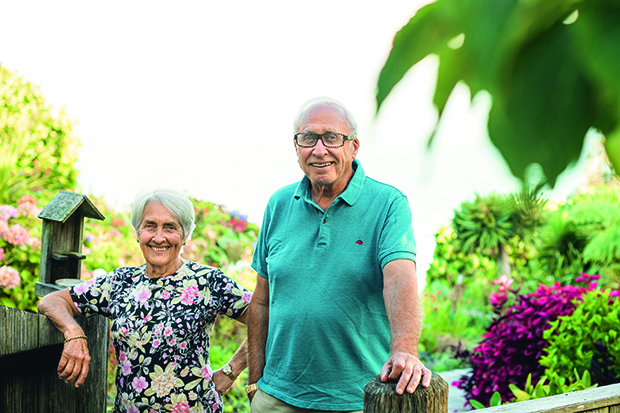
Gill and her brother Jack Richards were drawn to the steep site above Okitu Beach by the mesmeric Pacific Ocean view. Jack built a house first, and Gill got planting. Then she and her husband Colin built theirs. Initially, she grew anything that would survive the wind.
A brother, his hard-working sister and their partners created a forest on a hillside above the Pacific Ocean. It took more than three decades of hard yakka.
Words: Kate Coughlan Photos: Brennan Thomas
A tūī swooped low over grass-covered land above Okitu Beach, north of Gisborne near Wainui. It flew past a lone cabbage tree providing meagre cover for three cows with their heads low in the shade and over a car on the dirt road at the top end of the paddock.
The land rolled steeply down to a narrow beach, and the car’s occupants — two women and a man — got out and stood mesmerised by how the ocean uncoiled itself in regular, white-fringed folds on the sands below like a neatly placed blanket. They were silent and motionless. Nearby was a “for sale” sign.
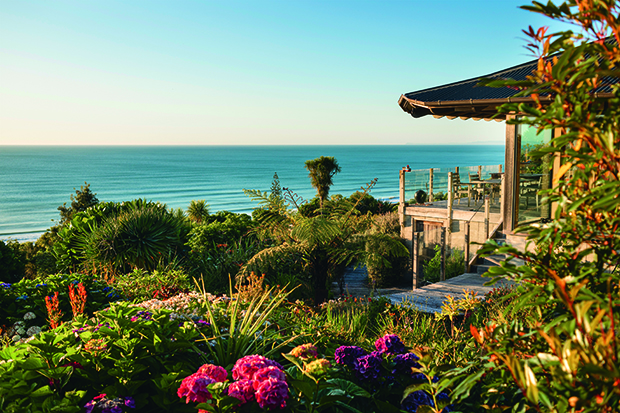
Gill found hydrangeas did surprisingly well when she began introducing colour. The banks north of her home are flourishing with mixes of natives, banksias, grevillea and hydrangeas.
To the tūī, the land was a disappointment. That one cabbage tree offered no potential home: no shelter, no food, no nesting sites. It should, however, have noted the beauty-struck humans and stayed around to see what they would do.
For that very spot, 30 years on, is a forest as tall as two men, too thick to push through and home to dozens of tūī. They wage aerial battles over especially delicious nectar, favoured nesting sites or prettier partners. Goodness knows what prompts them to whirl through leafy boughs in vigorous pursuit of each other. Not even Gill Armstrong knows the cause of these “wars of the tūī”, and she is the creator of the forest along with her husband, Colin, and her brother Jack Richards and his husband, Won Gyu.
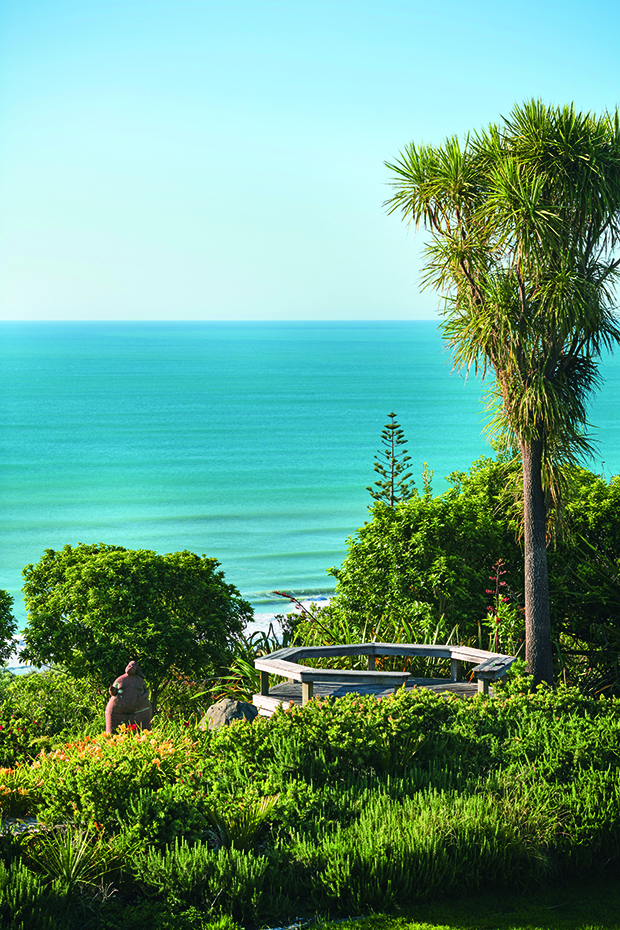
Locals favour this platform as a place for wedding ceremonies. “They like the ocean behind them and the garden in front,” says Gill Armstrong, the garden’s creator. The sentinel cabbage tree was a self-sown seedling when Gill first noticed it. She decided it had chosen a perfect spot. Today, it is a favourite haunt of tūī, especially when flowering.
Gill enjoys the drama-queen antics of the tūī as much as she loves all the heaving life this land is now home to — exotic and native. The glamorous star finches, orange breasts and parson birds living in luxury in two large aviaries, the turtles puddling about in a layered pond among the frogs and tadpoles, butterflies flitting between exotic plants, kererū crash-landing in the karaka for a lunch of ripe orange berries, the useful chickens scratching about and the companionable dogs…
And that view, the one that fascinated her and her brother Jack and their mother Kathleen Richards on that day in 1993 on their Sunday drive, can still halt her in her tracks for its sheer glory. Blue on blue on blue, all the way to a distant shimmering horizon.
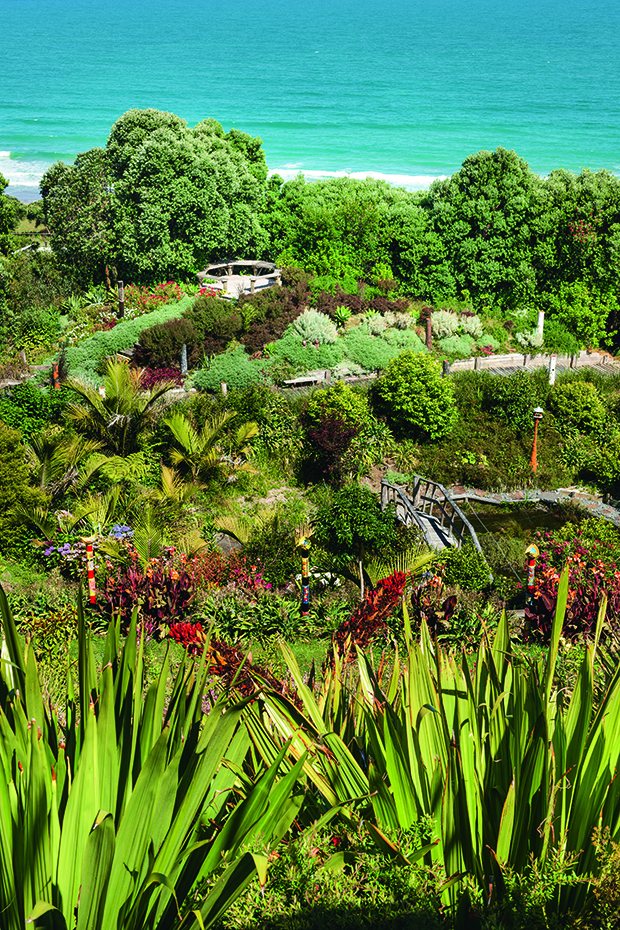
The lookout at Tiromoana (the name for Jack’s side of the garden) gives a great perspective of the Monet-inspired bridge and pond and meandering grass paths, alongside which are brightly coloured ceramic totems by Inglewood potters Brian and Patti Cocker. Pōhutukawa have outgrown the ocean view, but Gill can’t bring herself to cut down a tree. Australian spear lilies glow red hot in the foreground.
Jack initially decided to buy a piece of the hilltop block.
He was on one of his regular visits home to Gisborne from wherever abroad he was living at the time in a career as a specialist in second- and foreign-language teaching and the author of many books on the subject.
Today Jack lives permanently in Wellington, but in those days, he was mostly based in Southeast Asia.
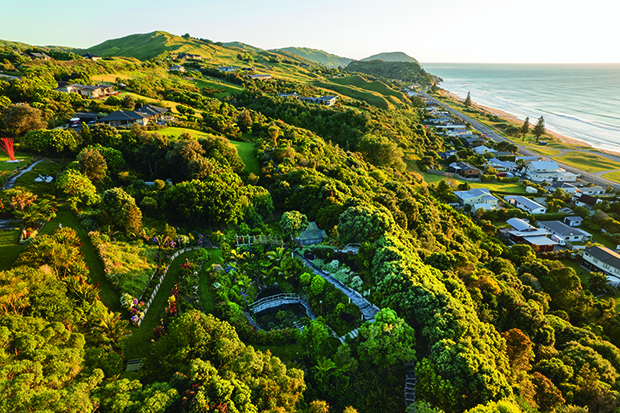
Gill’s korowai (cloak) of trees covers what was once farmland bare of any vegetation bar one cabbage tree. Gill and Colin’s house is visible left, and Jack’s is just out of shot to the left of the Kon Dimopoulos’ reed sculpture (far left), which dances hypnotically in the sea breeze. Walkways eventually lead to a boardwalk down into the forest of trees that have grown to 12 metres in height over the three decades since Gill got started.
Gill was busy in Gisborne city with Colin, raising three children, maintaining their 1350 square-metre section (a third of an acre), working (for 27 years) at the Gisborne Boys’ High School as the office receptionist and, almost as busy, founding a boys’ choir.
As Jack’s holiday home rose on that spectacular hillside site above Okitu Beach, it badly needed a garden, so Gill regularly went up the hill to Jack’s house to plant. She planted trees by the thousand and created paths through them by the tens of metres.
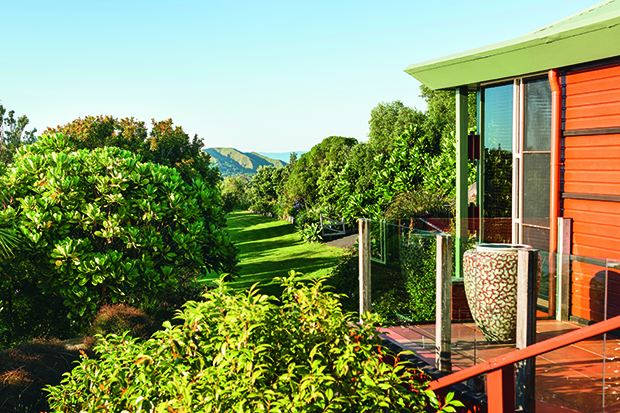
A medley of native trees, including pōhutukawa, tītoki, pūriri and karaka frame the lawn sweeping to the memorial garden for Jack and Gill’s parents, long-time Gisborne residents Kathleen and James Richards.
“I did it because I loved it, but I’d never gardened on a scale like this before, and I had no idea what I was doing initially or how to grow here. Soon I realised I could only plant what didn’t need water. You must have things that survive the dry and the heat.”
On and on she worked, and then she and Colin realised they, too, wanted to live at the top of the hill — permanently. When the land next to Tiromoana became available, Jack purchased a section for Gill and Colin, and they built their ocean-facing home and redoubled their efforts, planting on their land and Jack’s at a tūī-pleasing pace.
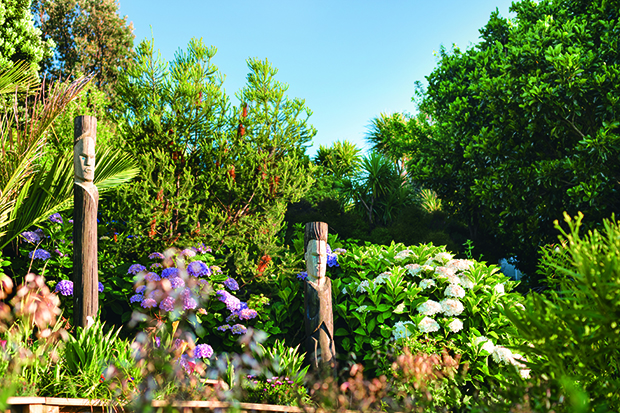
Students and teachers at Toihoukura (the Māori Arts course at the Eastern Institute of Technology) made these totems in Jack’s garden. Jack has supported Toihoukura for years and has many pieces from the school.
Sometimes Gill dragooned in members of her Gisborne Boys’ High School choir and the school’s first fifteen; “big strong boys and so willing to enjoy planting”. Sometimes she also took boys from the boarding hostel who could not travel to their own homes for free weekends. A happy combination of great tucker, hard work and nightly sing-alongs led to very productive planting sessions. Some of these boys (now men) still return to visit their forest today. For those decades, Gill enjoyed the challenges and the successes.
“At the start, it was all about getting shelter and starting things off. You want to fill up everything with plants, and then you get to the point where everything is too close and starts to crowd out other things. Once I reached that point, I could plant more beautiful things like rhododendrons and hydrangeas, which do surprisingly well now. And a few Australian and South African plants and shrubs also do well and provide colour and food for the birds, such as banksia, grevillea and proteas. I like the hot blaze of colour from the Australian spear lily [Doryanthus palmeri]. One of them sticks straight up, and the other bends over. They’re dramatic.”
- Hydrangea ‘Raspberry Crush’.
- Canna lily leaves.
- A ceramic by local sculptor Baye Riddell is surrounded by the soft grey foliage of armeria, a sea lavender that loves it hot and dry.
- Water lilies are grown in the big pond as turtles (in the house pond) eat them.
- Calla lilies thrive and provide welcome colour in early summer.
- Frothy blooms of the massed renga renga star in spring.
- Gill enjoys the marriage of Ligularia reniformis and daylilies.
- An unidentified succulent that has made the garden its own is an excellent gap-filler and edging plant.
Now that Gill is that bit older and aiming for less maintenance, she’s been trying to stop herself from creating new gardens. And in the past months, she and Colin — along with Jack and Won Gyu — began considering the unthinkable: selling their properties. Life inevitably moves on, and last Christmas, they decided to leave Tiromoana and their homes above the sea. Covid-19 had brought Jack and Won Gyu home from abroad to Wellington permanently with less need for a holiday home in Gisborne. And Gill says she and Colin know nothing stays the same forever.
“We have been so lucky to live here, and how blessed we are that things have grown so well. When I started, people told me, ‘You will never grow anything on that hillside. You are crazy.’ So I had to prove to myself that it could be done. It was hard work, but I loved it, and we had woofers — young people from all over the world — who helped with the tough stuff. You meet these delightful young people and get four hours of work five days a week in return for bed and board.
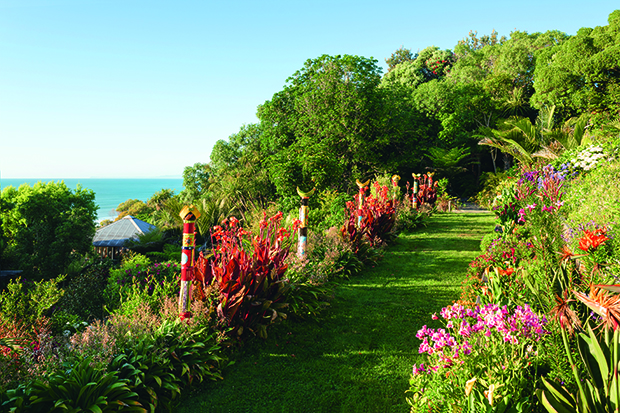
The Airbnb is tucked into the garden with privacy and uninterrupted ocean views.
“And living next to family has been great. Jack was mostly only home in the summer months, and when he was here, we’d share meals and have concerts at his place as he has a lovely grand piano. We share a strong interest in music. We’ve had singing and piano recitals; we like to foster music in our community.
“It’s been a great life here. I have simple tastes; I like nature in all its diversity. I enjoy the ocean providing endless interest with birds diving, people swimming and surfing, ships coming and going, a sea breeze in the summer. My mother always told me my house would be spotless if I spent as much time working on it as I did in the garden. Why would I bother?”
Now, Gill is looking forward to a different life in town with a flat section and time to do more things for others. When she thinks about leaving her garden of nearly three decades, she says to herself, “What a wonderful legacy to leave.” Indeed.
WHAT TO PLANT ON A STEEP CLAY SITE WITHOUT MUCH RAINFALL?
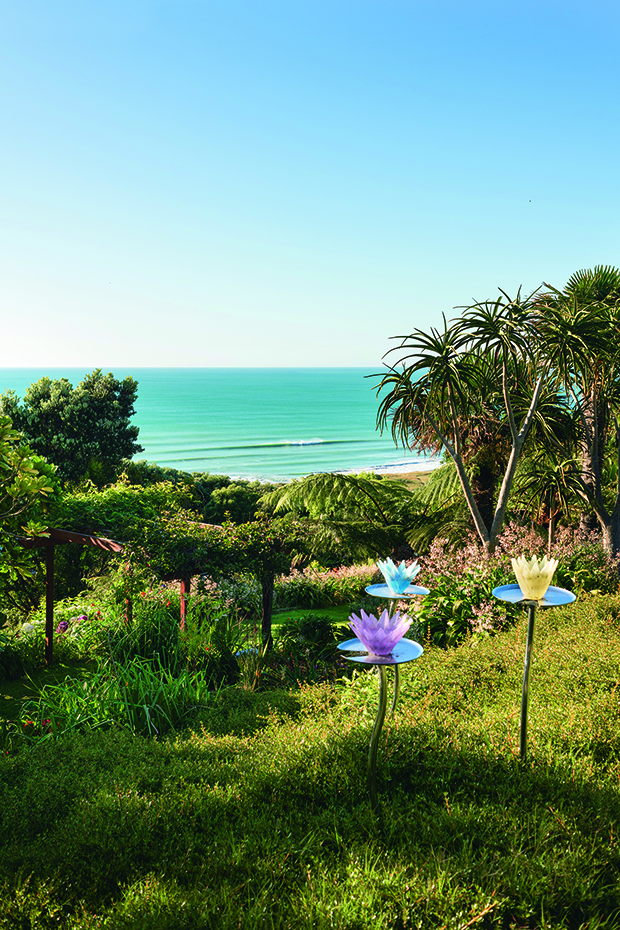
The glass sculptures of water lilies were originally located in the pond but were too hard to clean. Jack can’t recall where he got them or who made them, and Gill enjoys their whimsical presence floating above the surface of massed groundcover.
If Gill were to start again on a similar steep, east-facing site without topsoil in places and lacking a natural or supplied water system, she would plant pōhutukawa, pūriri, karaka and tītoki almost exclusively.
“These trees would be my mainstays. Pittosporums don’t last, puka don’t like getting wet feet — and that can happen in gullies — and they drop their leaves and die, and cabbage trees get disease and die…
“Anyway, if you plant cabbage trees too near lawns, you get chastised by your husband when they inevitably drop their leaves and interfere with the husband’s mower.
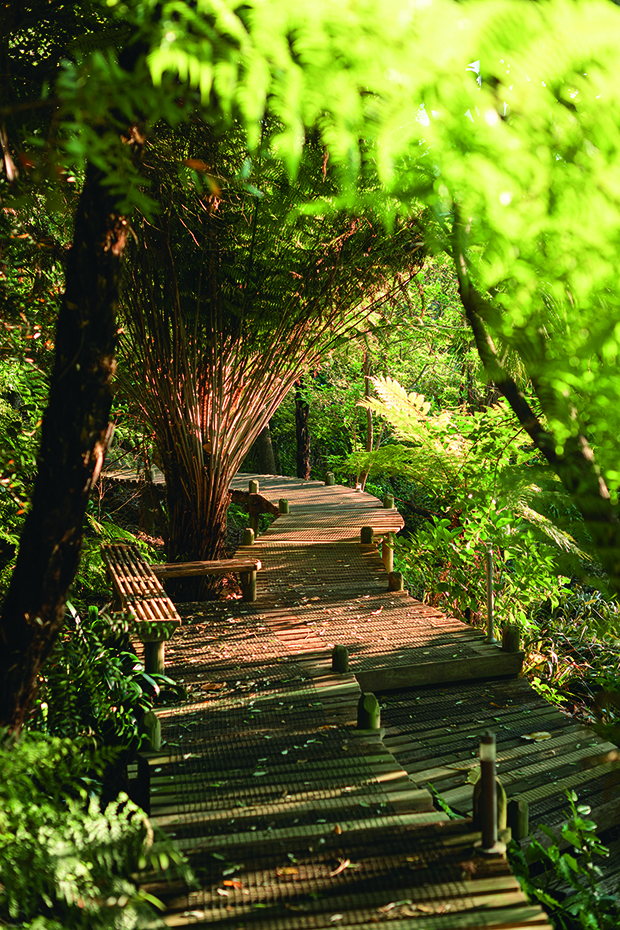
A trip nowadays to the beach is much easier than in Gill’s early days of planting the steep slopes when not disappearing down the hill was as challenging as getting a sapling into the soil.
“I wouldn’t plant ngaio as they die early with root rot from swaying so much in the wind. Kauri also do well here, and I’m propagating nīkau from seed these days — successfully, too. Nīkau and ferns grow well in the shade of the big trees, and I like to underplant with clivia to bring the first life in spring with their bright orange blooms.
“Banksias are good — they bring the birds. We have many tūī, but there is a tahi [No.1] tūī, and this seems to be his territory. There’s food all year round for him and his mates and for kererū — they love the pūriri and pōhutakawa.”
Love this story? Subscribe now!
 This article first appeared in NZ Life & Leisure Magazine.
This article first appeared in NZ Life & Leisure Magazine.
